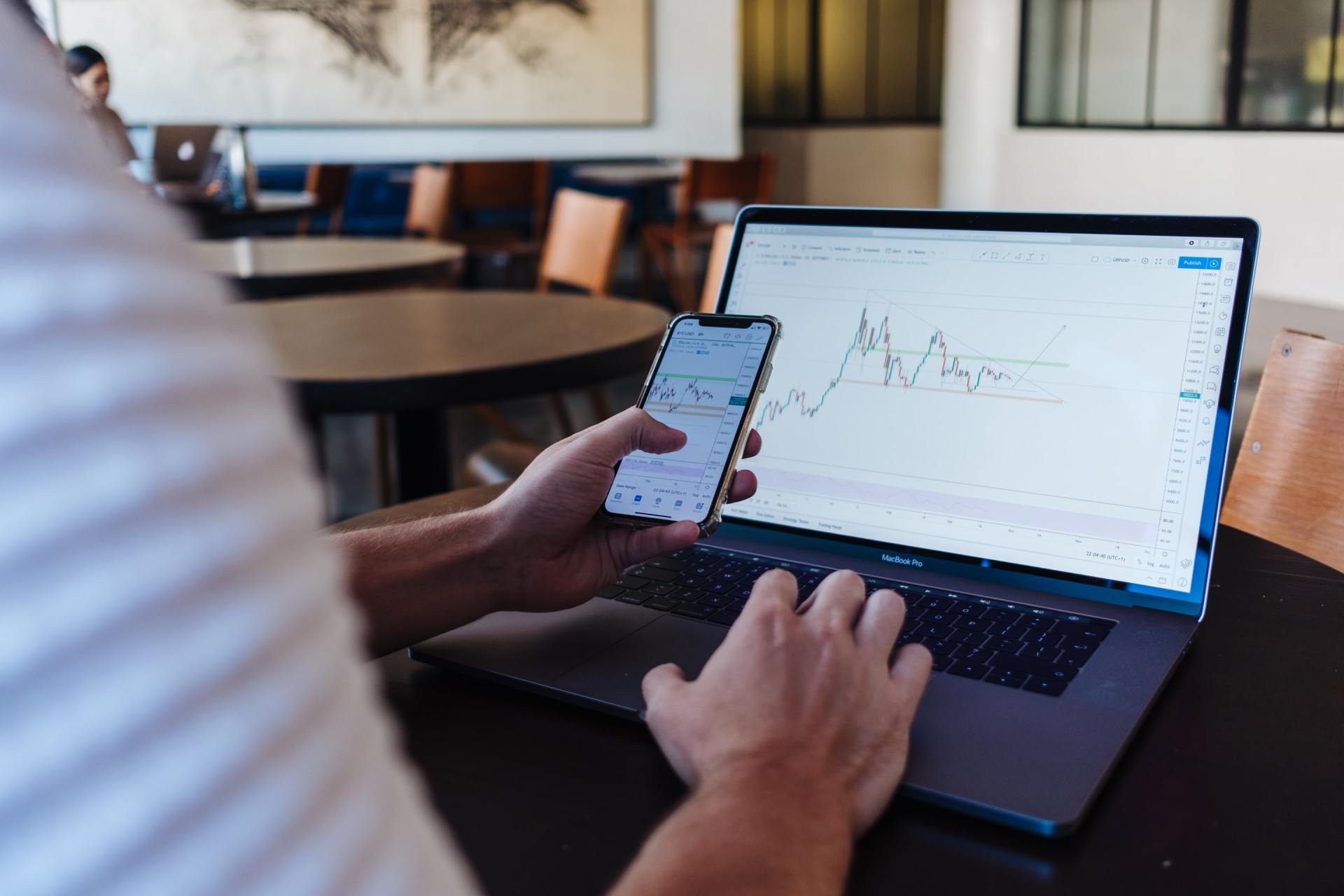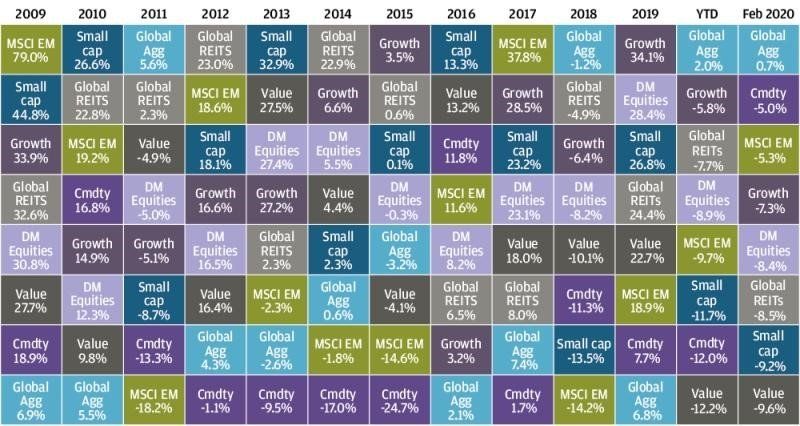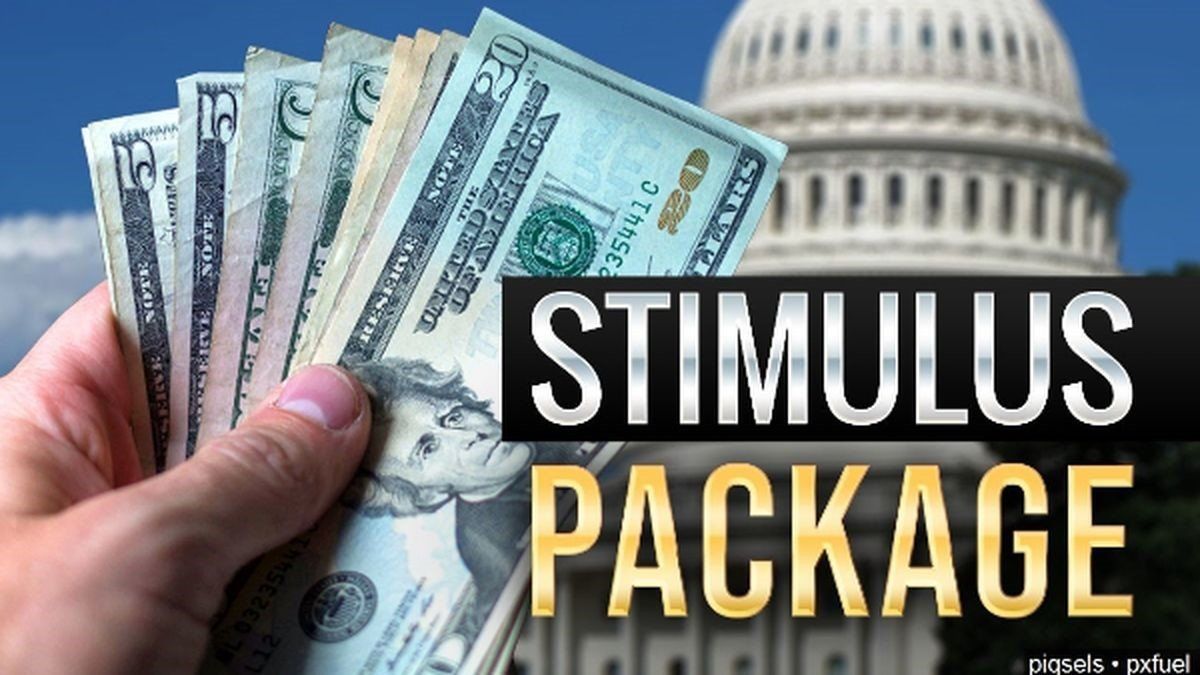Market Commentary | February 2020
Rob Kellogg, CFA®
March 3, 2020
THE MARKET
After starting the month off on a positive note, more fears surrounding the outbreak of the coronavirus (COVID-19) caused a significant downturn in equity markets to end the month.
The S&P 500 ended February down 8.41% and is now down 8.56% on the year. The NASDAQ composite was down 6.38% for the month and is now down 4.52% on the year. Bringing up the rear, the Dow Jones Industrial Average (DJIA) was down 10.05% for the month and is now down 10.94% on the year.1
The poor performance to end February is a quick reminder of the poor performance that occurred at the end of January this year.
There are parallels to the recent market selloffs that ended the first two months of 2020. The S&P 500 was down over 2% in the last week of January, only to recover and be up over 3% during the first week of February. The index was down nearly 9% during the last week of February only to post a positive day of 4.60% the first day of March.1
As we mentioned in last month’s commentary, nothing fundamental has changed within these U.S. companies in the index.
The coronavirus has caused transitory negative events that push down the stock price of these companies. Whether the virus is causing factories to slow production or causing retail stores to close shop for a few days, these are all temporary setbacks that can potentially create value for the investor. When the factories close or slow production, or when the retail stores close for a period, the fundamental aspects of the companies are not changing. They still have the same products, the same management (aside from Disney), and the same level of sophistication that it takes to succeed in this economy.
When the transitory negative event reverses (slowdown or containment of the virus), the companies will go back to their normal operations. The virus doesn’t have to be fully contained and a vaccine doesn’t have to be finalized in order for the negative event to reverse. The public panic simply has to subside.
We are in a headline driven world today. Social media and more ways for the public to consume news and headlines fuel the panic caused by the virus. As history has shown, eventually the panic will dissipate and normal day to day activities will resume. The panic could worsen over the next month or it could completely disappear. The important thing is that we don’t panic with our investment account as well. The image to the right, also pictured in last month’s commentary, shows the ability of global equity markets to persevere through past outbreaks.
As mentioned last month, we think that it is very possible to see a V shaped recovery bringing the market back to pre-virus levels, and we reiterate our position to stay disciplined in your current investment allocation. For less risk averse investors, the virus has created buying opportunities in the market. Looking at some well-known companies, they were all down significantly in the last week of February due to the virus, but all rebounded during the first day of March. Apple (AAPL) was down over 14% during the last week of the month and was up 9.31% on March 3rd. Microsoft (MSFT) was down over 10% and then was up 6.60%. Procter & Gamble (PG) was down nearly 12% and then was up 5.59%.3
As a whole, the DJIA was up over 5% on March 3rd, and the S&P 500 was up 4.60% to start the month.1
If you exited the market during the last week of February, you likely missed the recovery that occurred on Monday, March 3rd. It’s important to stay disciplined in both the short term and the long term. History has shown us that the market will recover. Whether it takes one day, one week, one month, or one year is anyone’s guess, but staying disciplined in your investment allocation will allow you to participate in the recovery. Trying to time the market regarding when to exit and when to reenter is not the best solution. It comes down to time in the market, not timing the market.
FIXED INCOME
Risk aversion seemed to be everywhere aside from fixed income last month as there was a flight to safety. Commodities fell just as equities did. The bright spot was fixed income with the Global Agg up 0.7% and U.S. Treasuries leading the fixed income sector being up 2.7% on the month.
The flight to safety increased bond prices and pushed down bond yields. We discussed the meaning of a flat yield curve last month which is when those with money to loan are willing to accept the same interest rate to loan their money short-term as they would if they loaned it long-term. An inverted yield curve means that the short-term instruments are yielding more than the long-term instruments. When the 1-year or 2-year Treasury is yielding more than the 10-year.
Previously, a few inversions in a row have preceded a recession. We had inversions in mid-1998 and early 2000 prior to the recession. We also had inversions in early 2006, mid-2006, and early 2007 prior to the Global Financial Crisis. As many investors are aware, we saw a brief inversion on February 25th last month. We actually had one in early 2019 as well.5
Does that mean we are on the way to a recession? In our opinion, and according to one former official at the Federal Reserve, not necessarily.
The Fed reacted to the early 2019 inversion with rate cuts and 2019 finished with the S&P 500 up over 30%.1
In an article written by Sunny Oh of MarketWatch, he interviewed PGIM Fixed Income chief economist Nathan Sheets, a former official at the Fed and the U.S. treasury department. According to the article, the intense focus on the predictive powers of the yield curve may have had the perverse consequence of making the bond-market gauge a less reliable recession indicator. The central bank’s preemptive action of lowering interest rates eased financial conditions and may have reduced the odds of a recession last year, undercutting the worrisome signal sent by the yield curve.
According to Sheets, “If you get in a world where the curve inverts and that makes the Federal Reserve, holding all else equal, more likely to ease policy, the curve inversion’s connection to recessions may be broken because the inversion is going to draw monetary stimulus that offsets it”. Sheets also added, “Once you start paying attention to any economic variable and you start using that as an indicator for policy, then the nature of that relationship to the economy is going to change”.
While Sheets isn’t dismissing the usefulness of the yield curve, he is simply stating that it is only one measure to forecast recessions, just as are corporate debt levels and unemployment claims.6
The major concern among investors when the yield curve inverts is that of tight financial conditions where banks aren’t willing to lend. However, if the inversions are causing the Fed to proactively ease financial conditions by lower rates, then the likelihood of a large downturn becomes smaller.
The next Federal Open Market Committee (FOMC) meeting is scheduled for late March and meeting minutes are likely to be monitored closely.7
Whether it’s positive or negative, you can expect to see market volatility resulting from the meeting as the Fed may or may not decide to lower rates.
Update: On Tuesday, March 3rd, the Fed decided to lower interest rates, the first emergency rate move since the depths of the Financial Crisis. This likely helps to validate Mr. Sheets’ above opinion.8
CONCLUSION
We believe that maintaining a balanced diversified portfolio could benefit investors. It’s possible that the panic surrounding the virus outbreak could continue causing bond yields to continue to decline and thus prices to increase then making core fixed income valuable to your portfolio. With the uncertainty of the news surrounding the virus, it’s also possible that risk aversion will not continue letting equities continue their rebound following the end of February.
The market selloff was mainly driven by fears of the coronavirus as it continues to spread. There are international companies closing doors until the virus can be contained, along with supply chain disruptions for some U.S. companies with operations overseas.
In today’s headline driven society, the volatility will continue for as long as the virus is in the news. We will see upticks when news of a vaccine leaks or signs of containment are seen, and we will see downticks when the number of cases increase or when a new city has a known case. It’s important to note that the virus is not changing the fundamentals of these companies. This is a temporary setback. A transitory negative event that likely creates value and buying opportunities. We recommend staying disciplined to your current investment allocations based on your risk tolerance, and if you’d like to revisit that, don’t hesitate to reach out.
With the U.S. Presidential Election set to take place in November, volatility is likely to occur through the remainder of the year. As of the writing of this commentary, Super Tuesday has yet to occur, but that is likely to cause even more short-term volatility. As a reminder, when the market is volatile, it’s important to avoid these mistakes.
- Emotional Decision Making – We have a plan in place that accounts for your goals, risk capacity, and time horizons. Stick to your plan.
- Recency Bias – Don’t drive in the rear-view mirror. Investments that were down today may be the ones that are up tomorrow.
- Not Understanding Your Investment Risk – We face multiple risk aspects in investing. If you are uncomfortable with your portfolio, we can re-evaluate and re-calibrate your portfolio to match your risk.
- Trying to Time the Market – It boils down to time in the market, not timing the market. Emotional reaction to real time news can trigger investors to sell low and buy high. Be patient.
- Narrow Investing without Proper Diversification – We work hard to create and deliver diversified portfolios that match your risk tolerance. If you have any questions or hesitations, let’s talk.
- Communication – We are here for you. It is important that you feel comfortable with your investments. It is also important that we understand your concerns. Please do not hesitate to call or e-mail us with any questions or concerns.
Returns are based on the S&P 500 Total Return Index, an unmanaged, capitalization-weighted index that measures the performance of 500 large capitalization domestic stocks representing all major industries. Indices do not include fees or operating expenses and are not available for actual investment. The hypothetical performance calculations are shown for illustrative purposes only and are not meant to be representative of actual results while investing over the time periods shown. The hypothetical performance calculations for the respective strategies are shown gross of fees. If fees were included returns would be lower. Hypothetical performance returns reflect the reinvestment of all dividends. The hypothetical performance results have certain inherent limitations. Unlike an actual performance record, they do not reflect actual trading, liquidity constraints, fees and other costs. Also, since the trades have not actually been executed, the results may have under- or overcompensated for the impact of certain market factors such as lack of liquidity. Simulated trading programs in general are also subject to the fact that they are designed with the benefit of hindsight. Returns will fluctuate and an investment upon redemption may be worth more or less than its original value. Past performance is not indicative of future returns. An individual cannot invest directly in an index.
Advisory Services offered through ChangePath, LLC a Registered Investment Adviser.
"The S&P 500 was down over 2% in the last week of January, only to recover and be up over 3% during the first week of February."
Source (2)
"The S&P 500 was down over 2% in the last week of January, only to recover and be up over 3% during the first week of February."
Source (4)
Source (4)
"The Fed reacted to the early 2019 inversion with rate cuts and 2019 finished with the S&P 500 up over 30%."
"It’s possible that the panic surrounding the virus outbreak could continue causing bond yields to continue to decline and thus prices to increase then making core fixed income valuable to your portfolio. "

November was a dizzying month for investors. The highlight? Earnings. 82% of companies1 beat estimates this quarter, despite headwinds such as supply chain constraints and inflation. The market’s biggest muse? Elon Musk’s twitter handle, with tweets such as (paraphrased) “should I sell 10% of my Tesla stock?” The most exciting job? Fed watcher. We started tapering, saw a plethora of hot inflation data, and gleaned insight from Federal Reserve Chair Jerome Powell on the last day of the month. November 2021 Market Returns

October was another positive month for the markets after September’s pullback. So far in 2021, the S&P 500 had nine positive performing months, September being the only hold out. The index ended up 6.9%, even though the first week of the month started a bit volatile. However, 2021 is looking robust, even if November and December aren’t large contributors, as the YTD performance through October is 23.9%. 1

As discussed in last month’s commentary, we felt November was going to be one of the more pivotal months that this country has seen in quite some time. Well, November lived up to its billing. As the page turned to the final month of the year, November experienced one of the most divisive U.S. Presidential Elections, the announcement of multiple vaccines’ effectiveness, and new all-time highs in the equity markets. December is sure to be intense as well while President Trump continues to contest the election, and as many states are determining how to handle the rise in cases of COVID-19 in tandem with the potential distribution of a vaccine. December will close the book on what has been one of the most interesting years in many of our lifetimes. We will keep this month’s commentary brief as we look forward to recapping the year in our annual commentary next month.

As discussed in last month’s commentary, we felt November was going to be one of the more pivotal months that this country has seen in quite some time. Well, November lived up to its billing. As the page turned to the final month of the year, November experienced one of the most divisive U.S. Presidential Elections, the announcement of multiple vaccines’ effectiveness, and new all-time highs in the equity markets. December is sure to be intense as well while President Trump continues to contest the election, and as many states are determining how to handle the rise in cases of COVID-19 in tandem with the potential distribution of a vaccine. December will close the book on what has been one of the most interesting years in many of our lifetimes. We will keep this month’s commentary brief as we look forward to recapping the year in our annual commentary next month.

As discussed in last month’s commentary, we felt November was going to be one of the more pivotal months that this country has seen in quite some time. Well, November lived up to its billing. As the page turned to the final month of the year, November experienced one of the most divisive U.S. Presidential Elections, the announcement of multiple vaccines’ effectiveness, and new all-time highs in the equity markets. December is sure to be intense as well while President Trump continues to contest the election, and as many states are determining how to handle the rise in cases of COVID-19 in tandem with the potential distribution of a vaccine. December will close the book on what has been one of the most interesting years in many of our lifetimes. We will keep this month’s commentary brief as we look forward to recapping the year in our annual commentary next month.

As discussed in last month’s commentary, we felt November was going to be one of the more pivotal months that this country has seen in quite some time. Well, November lived up to its billing. As the page turned to the final month of the year, November experienced one of the most divisive U.S. Presidential Elections, the announcement of multiple vaccines’ effectiveness, and new all-time highs in the equity markets. December is sure to be intense as well while President Trump continues to contest the election, and as many states are determining how to handle the rise in cases of COVID-19 in tandem with the potential distribution of a vaccine. December will close the book on what has been one of the most interesting years in many of our lifetimes. We will keep this month’s commentary brief as we look forward to recapping the year in our annual commentary next month.

As discussed in last month’s commentary, we felt November was going to be one of the more pivotal months that this country has seen in quite some time. Well, November lived up to its billing. As the page turned to the final month of the year, November experienced one of the most divisive U.S. Presidential Elections, the announcement of multiple vaccines’ effectiveness, and new all-time highs in the equity markets. December is sure to be intense as well while President Trump continues to contest the election, and as many states are determining how to handle the rise in cases of COVID-19 in tandem with the potential distribution of a vaccine. December will close the book on what has been one of the most interesting years in many of our lifetimes. We will keep this month’s commentary brief as we look forward to recapping the year in our annual commentary next month.

As discussed in last month’s commentary, we felt November was going to be one of the more pivotal months that this country has seen in quite some time. Well, November lived up to its billing. As the page turned to the final month of the year, November experienced one of the most divisive U.S. Presidential Elections, the announcement of multiple vaccines’ effectiveness, and new all-time highs in the equity markets. December is sure to be intense as well while President Trump continues to contest the election, and as many states are determining how to handle the rise in cases of COVID-19 in tandem with the potential distribution of a vaccine. December will close the book on what has been one of the most interesting years in many of our lifetimes. We will keep this month’s commentary brief as we look forward to recapping the year in our annual commentary next month.

As discussed in last month’s commentary, we felt November was going to be one of the more pivotal months that this country has seen in quite some time. Well, November lived up to its billing. As the page turned to the final month of the year, November experienced one of the most divisive U.S. Presidential Elections, the announcement of multiple vaccines’ effectiveness, and new all-time highs in the equity markets. December is sure to be intense as well while President Trump continues to contest the election, and as many states are determining how to handle the rise in cases of COVID-19 in tandem with the potential distribution of a vaccine. December will close the book on what has been one of the most interesting years in many of our lifetimes. We will keep this month’s commentary brief as we look forward to recapping the year in our annual commentary next month.

As discussed in last month’s commentary, we felt November was going to be one of the more pivotal months that this country has seen in quite some time. Well, November lived up to its billing. As the page turned to the final month of the year, November experienced one of the most divisive U.S. Presidential Elections, the announcement of multiple vaccines’ effectiveness, and new all-time highs in the equity markets. December is sure to be intense as well while President Trump continues to contest the election, and as many states are determining how to handle the rise in cases of COVID-19 in tandem with the potential distribution of a vaccine. December will close the book on what has been one of the most interesting years in many of our lifetimes. We will keep this month’s commentary brief as we look forward to recapping the year in our annual commentary next month.




